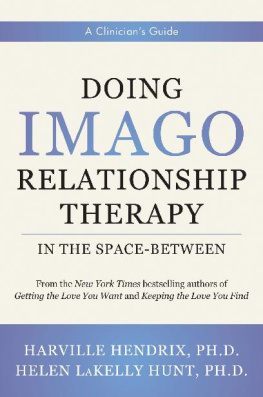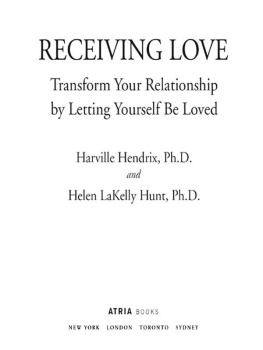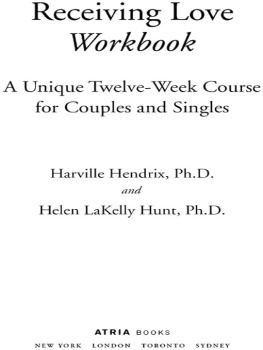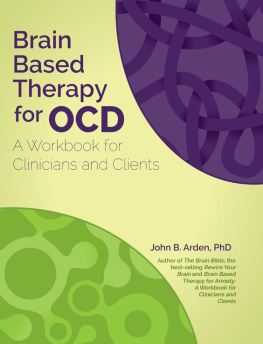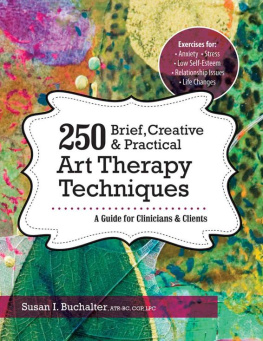A Clinicians Guide
DOING
IMAGO
RELATIONSHIP
THERAPY
IN THE SPACE-BETWEEN
HARVILLE HENDRIX, PH.D.
HELEN L A KELLY HUNT, PH.D.
A Norton Professional Book
This e-book contains some places that ask the reader to fill in questions or comments. Please keep pen and paper handy as you read this e-book so that you can complete the exercises within.
Contents
11:Dialogue:
The Commitment
FIGURES
TABLES
We wrote this book to answer a question: why do couples fight? We asked the question about forty years ago, right after we met. Both of us were troubled about our divorces, given that we were committed to marriage. In discussing our discomfort with our relational status, we expanded the question to: Why does the dream become a nightmare? And eventually, we asked: why does anyone fight? And finally, what is the source of human conflict? These questions sent us on a personal quest and research process that eventuated in Imago as an intellectual system operationalized as a couples therapy, a relational education process, and a social movement. And, to the conclusion that the answer to the why of couples conflict is the answer to the why of human conflict, and the solution to both is the same.
Although we come from opposite ends of the social and economic spectrum, we have similar childhood experiences which contributed, from the beginning, to a very complex and conflicted relationship that provided the perfect (though unplanned) laboratory within which we incubated ideas, invented new processes, and practiced new behaviors. The contribution each of us made was a function of our unique gifts, needs, resources and personal history, and therefore, in all respects, like having children, Imago is a co-creation that could not have developed without constant collaboration around the tension of our differences, and our mutual commitment to co-create a connecting, thriving relationship and a more effective therapeutic process for couples. The success of our relationship is largely a product of the experiments we developed to improve it. After testing them in the clinic, those that repeatedly worked became core theory and the practices that contributed to success of the Imago system.
Forty years ago, when we began our conversations, the field of couples therapy practiced what we now call parallel or therapist-centered psychotherapy. Since couples therapy is a derivative of psychotherapy, it made sense that the therapist would primarily interact with each partner to discover their history and their view of the problem, and then help them learn better communication skills that would resolve conflict and solve problems. However, the success rate of couples therapy then was about forty percent (Grande, 2017).
We decided to try something different. We created what we now call couple-centered therapy. In this type of therapy, the couple is the center and the therapist is at the periphery, facilitating a conversation between partners rather than talking to each partner in the presence of the other partner. The outcome of that was Imago Relationship Therapy, which we present in this book.
In these pages, we share a brief narrative of the sequence and process of our discovering and developing the core concepts and practices of Imago, with credits to couples who became our teachers.
IMAGO DIALOGUE
Our first discovery led to the creation of Imago Dialogue, the singular therapeutic intervention of Imago. We were about seven months into our relationship, which had always been intense and not always positive, when in the middle of an altercation, Helen stood up and adamantly said: Stop! One of us talk and the other listen, which we did. The deceleration of our negative feelings was so dramatic that it aroused our professional curiosity and we took the taking turns talking process to the clinic. As a precis to couples centered therapy (or Imago Therapy) we asked couples to face each other and then facilitated a conversation between them rather than with us. To structure the conversation and regulate affect, we eventually developed sentence stems. We asked the speaking partner to repeat the sentence stem and then to complete the sentence with their own content. The content exchanged was also regulated by asking couples to speak from their experience and refrain from any descriptions of their partner, either negative or positive, and to mirror accurately, and without comment, what their partner said.
The results were immediate. Couples calmed down and began to talkand more importantly, listento each other at deeper and deeper levels. As the energy between them changed from negative to positive, their glare was replaced with a gaze, anger gave way to tears, and avoidance was replaced with engagement and touch. We eventually developed taking turns into the three-step process: mirroring, validating, and empathizingcalled Imago Dialoguewhich has become Imagos central intervention. The most exciting and unexpected consequence of the dialogical process that we observed was the creation of safety. In a predictably safe environment, couples were enabled to relax their defenses, practiced since childhood, and become vulnerable and present to each other, effecting profound intrapsychic changes because of changes in the quality of their interactions with each other.
ZERO NEGATIVITY
Our second discovery was the necessity and power of Zero Negativity, removing all negativity from the relationship. We discovered the importance of this concept 18 years into our marriage, when we found ourselves at the brink of divorce. While separated, we decided to go on a date to a bookstore, our favorite activity. As a lark, we went to the esoteric rather than the psychological or philosophical sections we tended to haunt. There we discovered a book of essays on relationships between persons with different astrological signs. When we turned to VirgoAquarian relationships, we were shocked that the description of the intense negativity of couples with our astrological signs so accurately described our relationship. Taking it as a sign, Helen proposed that we begin the practice of eliminating negativity and use a calendar to record the days when either or both of us engaged in negative exchanges. If either experienced a negative message, we would quickly restore connection. Six weeks later, we began to experience dramatic change. And in nine months, we were ready for a recommitment ceremony and a new, dream marriage which has grown in richness and excitement ever since.
The lesson we learned from our experiment, and from observing the impact of negativity on other couples, was that negativity is fatal in relationships, and needs to be removed entirely. To implement its removal, we asked couples at the beginning of therapy to emulate what we were doing: remove all negative statementsshame, blame, guilting, etc.from their relationship and to keep track of their success with a calendar. After observing that all couples who committed to the process began to move through their impasse, we invented the concept of Zero Negativity, a clinical process of removing all negativity, and a reconnecting process to quickly restore connection when they failed. We then added the theory of Zero Negativity and the Zero Negativity process to the core of Imago theory and practice.




